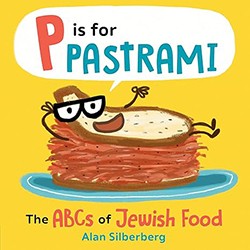You may think of fish and chips as a quintessentially British meal, with an origin almost as remote as Stonehenge. In fact, this combination dish was actually introduced to England in the nineteenth century by a Sephardic immigrant named Joseph Malin. In The Fabulous Tale of Fish & Chips, Helaine Becker and Omer Hoffmann tell his story as a classic example of persistence and imagination, as well as a reminder of the contributions of immigrants to their adopted homes. Becker’s text is attentive to the details that will appeal to young readers, and Hoffmann’s gently comic and historically accurate images give the book a delightful flavor.
Joseph works in his family’s shop. Fortunately, both for his customers and for today’s readers, he loves everything about fish, from buying it fresh in the market, to preparing it according to his grandmother’s recipe. Hoffmann’s drawing in sequence of the family matriarch cutting, coating, and frying the fish conveys the Malins’ dedication to their craft. Yet children will understand the difference between a person’s vocation and his ability to earn a living through it when Becker informs them that “Eating fish was one thing. That was easy. But selling it was hard.” Finally, in the midst of their household’s frenetic activity, Joseph conceives of an idea. Golden lines represent the aroma of fried fish surrounding him, while tiny dark spots of mental activity arise from his curly black hair. Their family will sell, not only fresh fish, but cooked plates of the new delicacy.
Conflict appears in the story when another young entrepreneur, Annette, resents his success, and decides that her grandmother’s recipe for fried potatoes has the same potential to attract customers. Annette has beautiful red hair and a look of determination on her face. When the two rivals literally crash into one another in the market, Hoffmann turns the cartoon-like event of near-disaster into a fortunate accident. There is an undertone of ethnic competition, along with a questioning of gender roles. In her author’s note, Becker explains that French and Belgian women may have brought fried potatoes to London’s East End as early as the seventeenth century. The same neighborhood eventually became a Jewish enclave. Certainly, the message of peaceful coexistence is part of Joseph and Annette’s decision to work together as they hawk their wares loudly, and “in perfect harmony.”
The interaction of words and pictures in this book is as harmonious as Joseph and Annette’s teamwork. Brief narration, glimpses into each character’s thoughts, and poetic phrases advance the plot. The book’s design takes full advantage of both color and blank space between images and texts, almost giving the sense of a graphic novel. Annette stands with one hand on her hip, the other casually tossing a potato in the air, as she imagines possibilities: “If Joseph can sell fried fish, why can’t I sell fried potatoes?” Soon she is hard at work, stirring a pot with so much energy that some of the potatoes fly into the air. Finally, she walks off the page with her tray of goods, followed by a goose who has trouble keeping up with her. Hoffmann uses humor to appeal to his readers, but always in an understated way.
There are elements that appeal to everyone here: family togetherness, immigrant ingenuity, friendship, and delicious food. Joseph Malin’s fried fish and potatoes, wonderful served hot and just as good eaten cold on Shabbat, finally have their origin story in this wonderful picture book.
In addition to the author’s note, her recipe for fried fish is included.
Emily Schneider writes about literature, feminism, and culture for Tablet, The Forward, The Horn Book, and other publications, and writes about children’s books on her blog. She has a Ph.D. in Romance Languages and Literatures.





